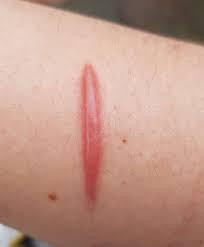What are Hypertrophic Scars?
Hypertrophic scars are fibrous tissue growths that form as the body's healing response following a deep cut, burn or other trauma to the skin. They are raised, red or dark purple thick scars that appear within weeks or months after the injury. However, unlike keloid scars which grow beyond the boundaries of the original wound, these scars remain within the borders.
Causes of Hypertrophic Scarring
Any severe injury to the dermal layer of the skin can potentially result in hypertrophic scarring. Common causes include:
- Surgery: Deep cuts and incisions from various surgical procedures are a major trigger for hypertrophic scarring. Surgical scars, especially those in high tension areas like shoulders and elbows, are more prone to becoming hypertrophic.
- Burns: Thermal or chemical burns, especially second-degree or worse burns that destroy the entire epidermis, are a leading cause of hypertrophic scars.
- Trauma: Deep lacerations, puncture wounds and abrasions caused by accidents, sharp objects or impact injuries may also scar hypertrophically during healing.
Risk Factors for Development
Certain genetic and biological factors increase one's predisposition to form hypertrophic scar tissue:
- Family History: People whose close relatives have hypertrophic or keloid scarring are more likely to experience the condition themselves. Genetics play a role in excessive wound healing response.
- Skin Type: Individuals with darker skin phototypes (IV-VI) typically have a higher risk than those with lighter skin tones. Melanin appears to correlate with exuberant scar formation.
- Age: Younger individuals (under 25 years) are generally more susceptible as their skin has a lower ability to remodel collagen. Scars often improve with age.
- Location: Areas like shoulders, chest, back and ears tend to scar hypertrophically as they have less elasticity and skin movement.
Characteristics
Hypertrophic scars typically display the following physical characteristics:
- Raised: They are elevated 0.5-1 cm above the surrounding skin level. The edges merge smoothly with normal skin.
- firm and rubbery texture: They have an irregular, nodular or rope-like texture due to abundant collagen deposition.
- red, dark purple or skin-colored: Depending on the recovery stage and skin pigmentation, they may range from bright red to purple or skin-toned.
- itchy: The dense collagen causes a sensation of itchiness in about 50% of cases.
- flexible yet non-stretchable: Unlike normal skin, hypertrophic scars have reduced pliability and do not allow much extension.
- permanent: Once formed, they usually remain lifelong unless treated. They may improve spontaneously over 1-3 years.
Complications
While it rarely pose serious health risks, they can cause significant cosmetic, functional and psychological problems:
- Disfigurement and poor cosmesis: Especially on exposed areas, they greatly detract from appearance.
- Pruritus or itching: Chronic itching impacts quality of life and can promote scratching and irritation.
- Functional impairment: Scar tissue in mobile areas limits normal joint/skin movement and causes discomfort.
- Psychosocial issues: self-consciousness about appearance leads to low self-esteem, anxiety and depression in some people.
- Scar widening/contracture: Over time, they may expand outwards or cause surrounding skin tightening/pulling in severe cases.
Treatment Options
Several therapeutic modalities are available to manage hypertrophic scars based on their severity and impact:
- Topical scar creams: Silicone-based gels raise scarcollagen levels and Texture. They work best on newer scars.
- Intralesional corticosteroid injections: Direct administration of medication tampers inflammation in mature scars.
- 5-fluorouracil (5-FU): This anti-metabolite chemcial is commonly injected to hinder fibroblast proliferation and collagen deposition.
- Laser treatments: Pulsed dye laser (PDL), fractional laser resurfacing etc help redistribute and soften scar pigmentation.
- Cryotherapy: Liquid nitrogen spray followed by compression is useful for thick scars.
- Scar revision surgery: Dermabrasion or excision plus grafting provides best results for severe, wide or contracted scars.
Preventing Hypertrophic Scarring
Proper wound management right from injury can aid scar prevention and control:
- Keep wounds moist with antibacterial ointment during recovery instead of dry scabbing.
- Use silicone gel sheeting 3-4 months post wound healing to soften scars while still immature.
- Massage or compress scar gently to spread collagen without stretching it more.
- Protect from sun exposure until scar fully matures after at least a year.
- Consider steroid injections early if at high risk of scarring due to family history.
- Control other risk factors like nutritional deficiency, obesity, smoking, etc.
While complete eradication of hypertrophic scars is difficult, a multidisciplinary approach tailored to each case can significantly improve appearance and symptoms. Early intervention usually leads to superior outcomes. Understanding scar biology and care goes a long way in prevention as well as management.
About Author:
Ravina Pandya, Content Writer, has a strong foothold in the market research industry. She specializes in writing well-researched articles from different industries, including food and beverages, information and technology, healthcare, chemical and materials, etc. (https://www.linkedin.com/in/ravina-pandya-1a3984191)
*Note:
1. Source: Coherent Market Insights, Public sources, Desk research
2. We have leveraged AI tools to mine information and compile it

